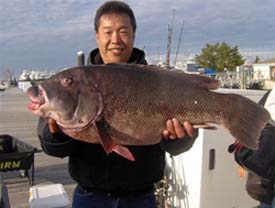| Old Time Togging By Mark Marquez II Posted 12/28/07 |
||
|
Pick up a book about the origins of saltwater sport fishing, and you might be surprised to discover that the earliest anglers worked some of the same grounds fished off New Jersey today. Works like George Reiger's Profiles in Saltwater Angling talk about steam ships running paid passengers to the banks off Sandy Hook to bottom fish for sea bass and porgies 160 years ago. Saltwater angling largely began in the New York Harbor area, quickly spread to waters off Sandy Hook in New Jersey and eventually trickled north and south. Not surprising, considering the population surrounding New York City. So anglers have fished New Jersey’s grounds practically as long as the sport has existed. This includes its tog fishing grounds. But things are different only one state to the south, in Delaware. “Delaware has tog fishing equivalent to New Jersey 20 years ago,” said Capt. Scotty Gold from Bandit Charters. “There’s no commercial or recreational pressure,” he said. “A lot of things are well preserved.” The Bandit fishes for the tog in 45- to |
|
Occasionally a party boat from Delaware Bay might appear, or so might a charter boat from Ocean City, Maryland. The average size of the blackfish can be considerably larger than in New Jersey and New York, Scotty said. And limits of the fish are not uncommon. The water can range 6 to 8 degrees higher than in New Jersey, and air temps can reach 6 to 10 degrees warmer, he said. This all means that when Jersey’s tog inevitably begin to stop biting at some point during winter, when cold water causes them to fall into a dormant state, Delaware’s tog keep feeding.
Tog fishers are one of the more obsessed anglers, and they’ll travel to pursue the sport. These finicky fish are somewhat challenging to catch, are hard fighters and can grow to 18 pounds. They’re also tasty. Delaware’s tog fishing is somewhat different than Jersey’s, because of strong currents that flow from Delaware Bay. While Jersey blackfish anglers traditionally keep the line taut, fishing in the Delaware currents is best with a touch of slack. The currents also require anglers to fish with heavier weights than in the generally slower currents off the Garden State. But the rigs used are the same as in New Jersey. Anchoring is also trickier in the currents. The location of the grounds off Delaware also protect them somewhat from northeast and east winds that wreak more havoc on seas off New Jersey. The proof of this fishing might be in the pudding, and the Bandit’s been attracting plenty of anglers on its trips. If you’re a tog fisher, check out Delaware in winter. |
||



 What’s more, when Jersey’s tog bag limit drops to four fish on January 1, Delaware’s limit remains 10 fish through March. Fourteen inches is the minimum length in both states during that period.
What’s more, when Jersey’s tog bag limit drops to four fish on January 1, Delaware’s limit remains 10 fish through March. Fourteen inches is the minimum length in both states during that period. 